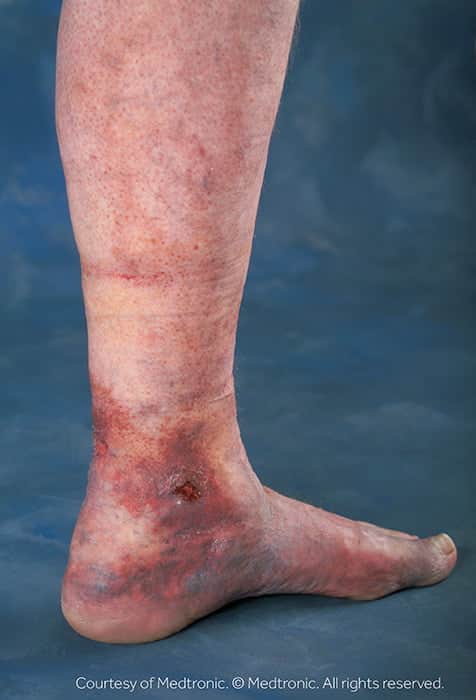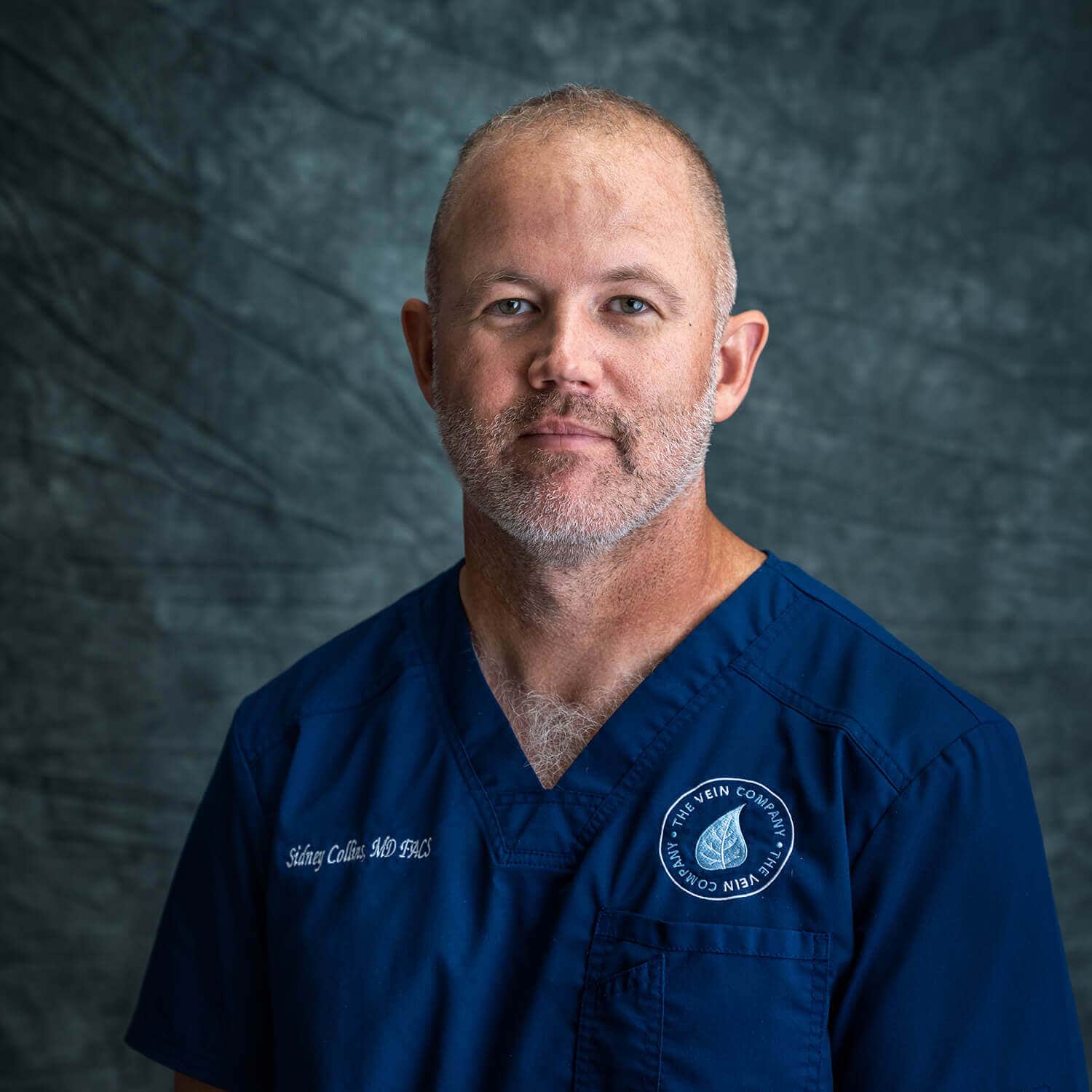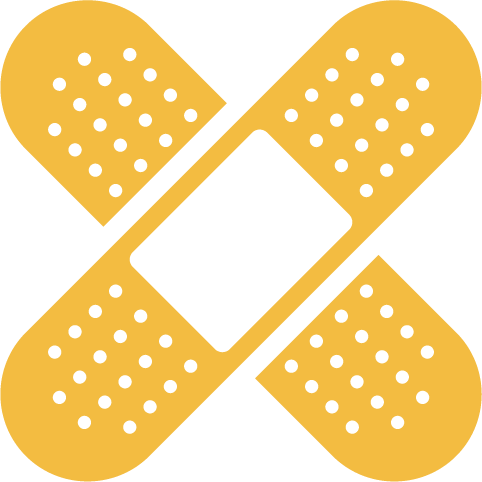Wound Care

Ulcers, Sores Or Wounds That Won’t Heal

Venous disease is a complex, progressive disease that, if left untreated, can lead to a variety of debilitating complications. Among these are ulcers, sores, or wounds that resist healing or persistently return even after healing. Proper wound care is crucial when dealing with untreated wounds caused by venous disease, also known as chronic venous insufficiency, as they can significantly impact your quality of life. In this context, understanding the importance of wound care becomes paramount in managing and alleviating the adverse effects of this condition.
Veins have valves that are one-way gates to keep the blood flowing in one direction back to the heart. With chronic venous insufficiency, the valves stop working properly, allowing blood to pool in the lower leg and around the ankles. The pressure on the skin caused by the pooling blood and excess fluid can break down the skin and cause a sore or wound to open on the skin surface, usually on the inner side of the lower leg.
You might experience swelling of the leg and the skin around it becoming dry and itchy and reddish in color. The wound itself typically has a weeping, raw appearance and is often mistaken for an infected sore. Because the majority of leg ulcers are the result of venous insufficiency they cannot be treated with just topical creams or salves alone. For the best healing rates, venous ulcers should be treated by an expert in venous disease and wound care.
What causes venous leg ulcers and who is at risk?
Venous ulcers or wounds are open sores on the skin that do not heal. They can affect any area of the skin, but they most often occur on the lower legs below the knee. Venous wounds are a result of problems with blood flow (circulation) in your leg veins. Eighty percent of lower leg wounds are the result of untreated, underlying venous disease, also known as chronic venous insufficiency. Venous leg ulcers occur in both men and women.
Risk factors include:
- Heredity
- Multiple pregnancies
- Aging
- Leg injury or major surgery of the leg
- Prolonged standing or sitting
- Obesity

What are the symptoms?
The first signs that you are developing a venous leg ulcer are:
- Leg or ankle swelling.
- Leg pain, aching or cramping
- Skin changes or rashes. The area may have a burning or itching sensation.
- The skin is brownish-red and dry, typically below the calf.
Once the ulcer has developed:
- The wound is often wet or weeping and may have a yellow-white film over it.
- The skin around the wound is often discolored and swollen and may feel warm.

Venous ulcers need proper care and treatment from an experienced provider to prevent infection, to heal the wound as quickly as possible, and keep it from reoccurring. It’s important to have any venous wounds checked right away by a healthcare provider.
The First Step Is To Heal The Wound
At The Vein Company we have an experienced team that can address any underlying issues at the same time that we are treating your ulcer. This is essential to the long-term health of your legs. This condition will not correct itself and will progressively become worse over time if left untreated.
The Vein Company has years of experience working with patients who suffer from this condition, and our well-trained, knowledgeable staff are experts on how to treat it. We are committed to treating venous disease and the wounds that are caused by it.
Don’t be sidelined in life by debilitating wounds. Seek treatment today with the specialists at The Vein Company! Patients are actually amazed at how their quality of life improves with corrective treatment!
Finally, We Treat The Underlying Cause
The Vein Company’s experienced staff are well trained to not only treat the wound but also to treat the underlying conditions that are causing the wound. Without proper treatment of the vein disease, it is very likely that the wound will not heal in an appropriate amount of time or will continue to reoccur after healing.
To begin the healing process of the wound, we will first remove the old skin tissue to provide a clean healing surface. You should expect the provider to cover and protect the ulcer with a medicated wound wrap called an Unna boot. Then, depending on the wound size, it may take three to six months to heal. You will see our providers every seven to 10 days for management as the healing progresses. The healing time will vary depending on the size of the wound.
Meet Our Wound Care Team

Abingdon
Dr. Sidney Collins, MD, FACS
General and Vascular Surgery

Abingdon
Ashley Ball, FNP-C
Wound Care Nurse Practitioner
FIVE TIPS TO HELP SUPPORT THE WOUND HEALING PROCESS
 Follow your healthcare provider’s instructions regarding dressing changes
Follow your healthcare provider’s instructions regarding dressing changes
 Do not apply any creams or lotions to your wound unless instructed by your healthcare provider
Do not apply any creams or lotions to your wound unless instructed by your healthcare provider
 Keep your wound and dressing dry or as instructed by your healthcare provider
Keep your wound and dressing dry or as instructed by your healthcare provider
 Watch for signs of infection
Watch for signs of infection
 Return for appointments
Return for appointments
Preventing venous wounds
To prevent venous wounds, you first need to prevent the underlying cause, vein disease. You can do this by having healthy habits that help the blood flow in your legs. These lifestyle changes can improve your circulation and reduce the risk for developing lower leg wounds:
- Avoid smoking
- Lose weight if you’re overweight or obese
- Stay at your ideal weight
- Get plenty of regular exercises. Walking is a great exercise to keep your veins healthy
- Move around often, don’t sit or stand in one place for long periods of time
- Raise (elevate) your legs for a short time, especially if you’ve been standing all day
- Wearing compression stockings can also help. They can help prevent blood from pooling in your legs and reduce swelling
Wound Care

Ulcers, Sores Or Wounds That Won’t Heal

Venous disease is a complex, progressive disease that, if left untreated, can lead to a variety of debilitating complications. Among these are ulcers, sores, or wounds that resist healing or persistently return even after healing. Proper wound care is crucial when dealing with untreated wounds caused by venous disease, also known as chronic venous insufficiency, as they can significantly impact your quality of life. In this context, understanding the importance of wound care becomes paramount in managing and alleviating the adverse effects of this condition.
Veins have valves that are one-way gates to keep the blood flowing in one direction back to the heart. With chronic venous insufficiency, the valves stop working properly, allowing blood to pool in the lower leg and around the ankles. The pressure on the skin caused by the pooling blood and excess fluid can break down the skin and cause a sore or wound to open on the skin surface, usually on the inner side of the lower leg.
You might experience swelling of the leg and the skin around it becoming dry and itchy and reddish in color. The wound itself typically has a weeping, raw appearance and is often mistaken for an infected sore. Because the majority of leg ulcers are the result of venous insufficiency they cannot be treated with just topical creams or salves alone. For the best healing rates, venous ulcers should be treated by an expert in venous disease and wound care.
What causes venous leg ulcers and who is at risk?
Venous ulcers or wounds are open sores on the skin that do not heal. They can affect any area of the skin, but they most often occur on the lower legs below the knee. Venous wounds are a result of problems with blood flow (circulation) in your leg veins. Eighty percent of lower leg wounds are the result of untreated, underlying venous disease, also known as chronic venous insufficiency. Venous leg ulcers occur in both men and women.
Risk factors include:
- Heredity
- Multiple pregnancies
- Aging
- Leg injury or major surgery of the leg
- Prolonged standing or sitting
- Obesity

What are the symptoms?
The first signs that you are developing a venous leg ulcer are:
- Leg or ankle swelling.
- Leg pain, aching or cramping
- Skin changes or rashes. The area may have a burning or itching sensation.
- The skin is brownish-red and dry, typically below the calf.
Once the ulcer has developed:
- The wound is often wet or weeping and may have a yellow-white film over it.
- The skin around the wound is often discolored and swollen and may feel warm.

Venous ulcers need proper care and treatment from an experienced provider to prevent infection, to heal the wound as quickly as possible, and keep it from reoccurring. It’s important to have any venous wounds checked right away by a healthcare provider.
The First Step Is To Heal The Wound
At The Vein Company we have an experienced team that can address any underlying issues at the same time that we are treating your ulcer. This is essential to the long-term health of your legs. This condition will not correct itself and will progressively become worse over time if left untreated.
The Vein Company has years of experience working with patients who suffer from this condition, and our well-trained, knowledgeable staff are experts on how to treat it. We are committed to treating venous disease and the wounds that are caused by it.
Don’t be sidelined in life by debilitating wounds. Seek treatment today with the specialists at The Vein Company! Patients are actually amazed at how their quality of life improves with corrective treatment!
Finally, We Treat The Underlying Cause
The Vein Company’s experienced staff are well trained to not only treat the wound but also to treat the underlying conditions that are causing the wound. Without proper treatment of the vein disease, it is very likely that the wound will not heal in an appropriate amount of time or will continue to reoccur after healing.
To begin the healing process of the wound, we will first remove the old skin tissue to provide a clean healing surface. You should expect the provider to cover and protect the ulcer with a medicated wound wrap called an Unna boot. Then, depending on the wound size, it may take three to six months to heal. You will see our providers every seven to 10 days for management as the healing progresses. The healing time will vary depending on the size of the wound.
Meet Our Wound Care Team

Abingdon
Dr. Sidney Collins, MD, FACS
General and Vascular Surgery

Abingdon
Ashley Ball, FNP-C
Wound Care Nurse Practitioner
FIVE TIPS TO HELP SUPPORT THE WOUND HEALING PROCESS
 Follow your healthcare provider’s instructions regarding dressing changes
Follow your healthcare provider’s instructions regarding dressing changes
 Do not apply any creams or lotions to your wound unless instructed by your healthcare provider
Do not apply any creams or lotions to your wound unless instructed by your healthcare provider
 Keep your wound and dressing dry or as instructed by your healthcare provider
Keep your wound and dressing dry or as instructed by your healthcare provider
 Watch for signs of infection
Watch for signs of infection
 Return for appointments
Return for appointments
Preventing venous wounds
To prevent venous wounds, you first need to prevent the underlying cause, vein disease. You can do this by having healthy habits that help the blood flow in your legs. These lifestyle changes can improve your circulation and reduce the risk for developing lower leg wounds:
- Avoid smoking
- Lose weight if you’re overweight or obese
- Stay at your ideal weight
- Get plenty of regular exercises. Walking is a great exercise to keep your veins healthy
- Move around often, don’t sit or stand in one place for long periods of time
- Raise (elevate) your legs for a short time, especially if you’ve been standing all day
- Wearing compression stockings can also help. They can help prevent blood from pooling in your legs and reduce swelling